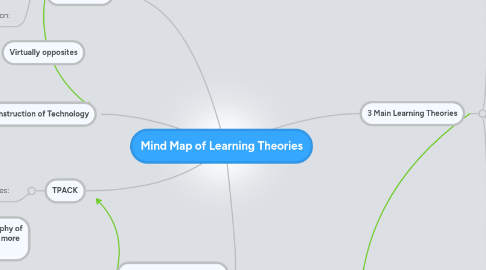
1. Media Ecology
1.1. The study of how media and technology effects humans and their interactions
1.1.1. Why does media influence us, our choices, our actions and our learning?
1.2. Implications for Education:
1.2.1. -Media effects our students immensely, as their lives practically revolve around social media
2. Social Construction of Technology
2.1. Human action shapes technology
2.2. Implications for Education:
2.2.1. -Our students can change technology, not the other way around.
3. Virtually opposites
4. TPACK
4.1. Basic Principles:
4.1.1. -Combination of the knowledge of content, pedagogy and technology, and their combined use in the classroom.
4.1.1.1. -How much of each is ideal to maximize learning?
5. Philosophy of Teachnology
5.1. Basic Principles:
5.1.1. -Combination of the Philosophy of Teaching with the use and beliefs regarding the use of technology in the classroom
5.1.1.1. -What do I believe about myself as a teacher?
5.1.1.2. -What are my beliefs about the use of technology in the classroom?
6. Very similar, but the Philosophy of Teachnology is significantly more personal
7. All three styles of learning can use technology as a form of delivery
8. 3 Main Learning Theories
8.1. Behaviourism
8.1.1. Basic Principles:
8.1.1.1. -Stimulus and Response theory using positive and negative reinforcement, as well as punishment for negative behaviours.
8.1.1.2. -Uses conditioning to ensure learning
8.1.2. Implications for Education:
8.1.2.1. -Assumes students will respond to a stimulus in the classroom and continue, after said stimulus, to produce the same product
8.1.2.2. -Enforces punishment for unwanted student behaviours
8.1.2.3. -Emphasizes repetition as a learning tool
8.1.2.4. -Teacher-based instruction in lecture format
8.1.3. Famous behaviourist: Pavlov
8.2. Cognitivism
8.2.1. Basic Principles:
8.2.1.1. -Short-term, long-term, and working memory
8.2.1.2. -Knowledge is active and organized
8.2.1.3. -Prior knowledge affects what we know
8.2.1.4. -Presentation of information is key to preservation
8.2.2. Implications for Education
8.2.2.1. -Uses memory devices, such as mnemonics, to ensure learning occurs
8.2.2.2. -Suggests that students are only capable of taking in so much to their working memory; anything else becomes cognitive overload
8.2.2.3. -Visual organization of a lesson matters to ensure learning
8.2.3. Famous Cognitivists: Piaget & Vygotsky
8.3. Constructivism
8.3.1. Basic Principles:
8.3.1.1. -Learning through active interaction with the environment
8.3.1.2. -Uses complex problems to teach skills
8.3.1.3. -Learner builds their own knowledge through experience
8.3.2. Implications for Education:
8.3.2.1. -The teacher should be the facilitator of learning: allowing the child to learn for themselves by demonstrating problems where the child is the problem-solver
8.3.2.2. -Problem-based style questions
8.3.2.3. -Use of hands-on experience to learn
8.3.2.4. -Group work
